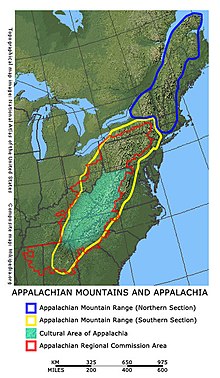
Environmental issues in Appalachia, a cultural region in the Eastern United States, include long term and ongoing environmental impact from human activity, and specific incidents of environmental harm such as environmental disasters related to mining. A mountainous area with significant coal deposits, many environmental issues in the region are related to coal and gas extraction. Some extraction practices, particularly surface mining, have met significant resistance locally and at times have received international attention.[1]
Besides coal mining and natural gas extraction, Appalachia faces other environmental issues, including deforestation, soil erosion, climate change, and water scarcity. Deforestation has negatively impacted the region's biologically diverse forests, reducing habitat for various species and altering the forest ecosystem. The steep slopes and heavy rainfall in Appalachia make it susceptible to soil erosion, which can be worsened by land use changes like logging and mining, leading to sedimentation in rivers and streams. Climate change has also affected the region, causing more frequent and severe weather events, shifts in precipitation patterns, and changes in seasonal events. While Appalachia is known for its abundant water resources, water scarcity is a concern in some areas, especially during droughts, which can be worsened by climate change and industrial water withdrawals.[2]
Additionally, black lung disease has been prevalent in the Appalachia region. This disease is common in coal workers due to the inhalation of coal and silica dust in mining sites. Appalachia emerges as the hotspot of this disease, even in lower-class neighborhoods. Minimal screening of the disease has been registered even after passing the Coal Mine Health and Safety Act as early as 1969. There is an urgent need for public health policy in the area to regulate the impacts of coal mining on the spread of black lung disease.[3]
- ^ Cite error: The named reference
:02was invoked but never defined (see the help page). - ^ Cianciolo, T. R., McLaughlin, D. L., Zipper, C. E., Timpano, A. J., Soucek, D. J., & Schoenholtz, S. H. (2020). Impacts to water quality and biota persist in mining-influenced Appalachian streams. Science of the Total Environment, 717, 137216.
- ^ This finding is based in Shriver, T. E., & Bodenhamer, A. (2018). The enduring legacy of black lung: environmental health and contested illness in Appalachia. Sociology of health & illness, 40(8), 1361-1375.